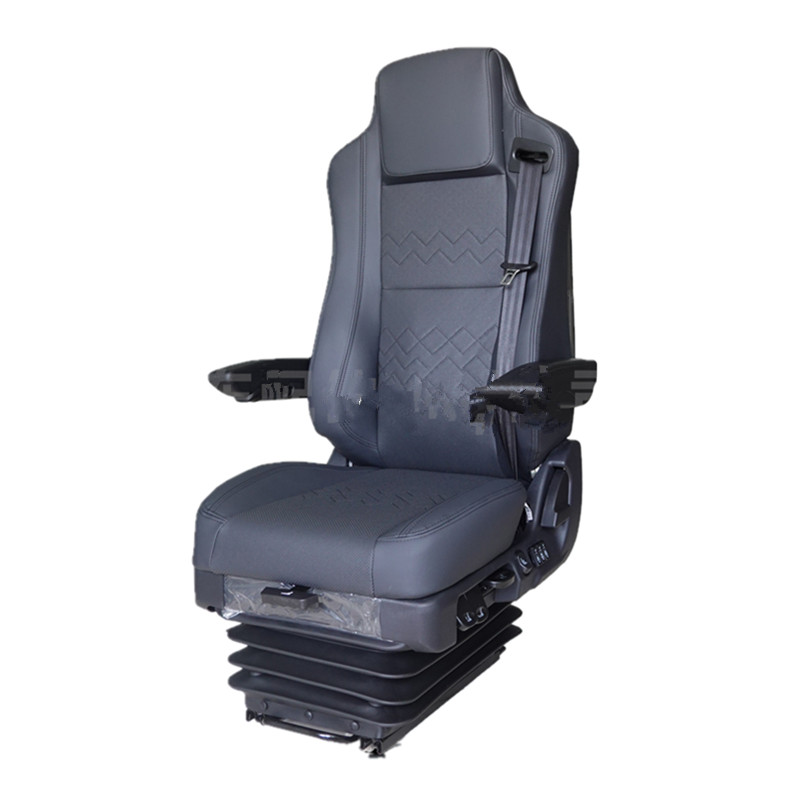How Do Truck Seat Fabric Materials Affect Comfort?
How Do Truck seat Fabric Materials Affect Comfort?
1. Classification and Characteristics of Truck seat Fabric Materials
1.1 Wear-Resistant Fabric
Wear-resistant fabric is one of the most widely used materials for Truck seats, mainly including polyester fiber, nylon fiber, and various blended fabrics. Its core advantages lie in excellent durability and cost-effectiveness, making it particularly suitable for frequently used truck environments.
As the most common seat fabric material, polyester fiber (polyester) boasts high strength, tear resistance, and outstanding wear resistance. Its stable molecular structure resists UV radiation and chemical erosion, maintaining consistent performance across various climatic conditions. Tested to industry standards such as Martindale or Taber, polyester fiber typically withstands over 50,000 cycles without significant wear. In practical applications, 100% polyester Truck seat fabric offers good wrinkle resistance and UV protection, effectively shielding the seat from sun and rain while featuring antibacterial and anti-mite properties.
Nylon fiber excels in strength and durability, with unparalleled resilience, excellent wind and water resistance, and good elasticity—ideal for harsh environments. Its high elasticity adapts to various body movements, reducing fatigue during long drives. In Truck seats, nylon fiber is often blended with other fibers to enhance overall performance.
Blended fabrics achieve performance complementarity and optimization through scientific fiber proportioning. Common blends include polyester-cotton and polyester-wool. When the blend ratio is "50%-70% recycled polyester staple fiber + 30%-50% cotton fiber," the fabric's air permeability reaches 800-1200mm/s (per GB/T 5453 standard), far exceeding pure recycled polyester staple fiber fabric (approximately 500-700mm/s) and offering comfort close to pure cotton. This blend design not only improves air permeability but also enhances moisture absorption, keeping the seat dry and comfortable during prolonged use.
In addition to traditional woven and knitted fabrics, mesh fabrics are increasingly used in Truck seats. Featuring a special weaving process that creates numerous air holes, mesh fabrics significantly enhance air circulation. Particularly suitable for hot climates, they effectively reduce stuffiness and sweat accumulation.
1.2 Leather Fabric
As the preferred material for high-end Truck seats, leather fabric mainly includes natural leather and various leather substitutes. Natural leather, predominantly cowhide, is widely used in mid-to-high-end vehicle seats for its combination of luxury and comfort. Thanks to the chemical properties and triple-helix structure of collagen, natural leather offers softness, wear resistance, high strength, excellent moisture absorption, and breathability.
In terms of physical properties, natural leather exhibits superior mechanical performance. Test data shows its tensile strength typically exceeds 15MPa with an elongation at break of over 50%, outperforming PU microfiber leather in both warp and weft tensile strength. Its moisture vapor transmission rate is nearly twice that of PU microfiber leather, attributed to larger, more uniformly distributed collagen fibers and a higher proportion of microporous space, creating natural breathable channels. This excellent breathability allows leather seats to quickly dissipate heat and moisture, maintaining a dry and comfortable seating experience.
However, natural leather has inherent drawbacks. In folding resistance tests, samples aged under damp-heat (168h/70℃/75%) and high-temperature conditions develop cracks or stress whitening after 7500-8500 folds—less rigorous than the 240h/90℃/95% aging conditions endured by PU microfiber and PVC synthetic leather. In wear resistance tests, natural leather samples show approximately 10 holes after 1800-1900 abrasion cycles, significantly inferior to PU microfiber and PVC synthetic leather, which remain intact after 19,000 cycles.
In high-end truck applications, different grades of natural leather are widely used. Full-aniline and semi-aniline leather represent the highest quality, requiring strict material selection and lengthy processing—commonly used in premium models. Nappa leather, also known as calfskin, is favored for its soft, delicate texture. Top-tier trucks like the Scania 770S feature leather upholstery on seats and berths, with exquisite designs including leather-wrapped front and passenger seats, V8 logos embossed on headrests, and honeycomb patterns on backrests and cushions outlined by fine gold stitching.
1.3 Synthetic Leather Fabric
As a substitute for natural leather, synthetic leather plays a crucial role in Truck seat applications, mainly consisting of polyvinyl chloride (PVC) synthetic leather and polyurethane (PU) microfiber synthetic leather. These materials strike a balance between performance and cost.
PVC synthetic leather, the first generation of artificial leather developed in the 1930s, offers high strength, wear resistance, fold resistance, acid-alkali resistance, low cost, and easy processing. Its structure includes a surface coating, dense PVC layer, foamed PVC layer, PVC adhesive layer, and polyester base cloth, manufactured via the release paper (transfer coating) process. In terms of performance, PVC synthetic leather exhibits good wear resistance (intact after 19,000 ball-plate abrasion cycles), excellent environmental durability (resisting damp-heat, high/low temperatures, and climate alternations), and good dimensional stability (shrinkage <5% at 120℃/168h).
However, PVC synthetic leather has obvious shortcomings: nearly zero moisture vapor transmission, poor breathability, easy aging, hardening and cracking at low temperatures, poor slip resistance, heavy use of harmful plasticizers causing pollution, and strong odors. These limitations restrict its use in high-end Truck seats, making it suitable primarily for cost-sensitive economic models.
Developed successfully in the 1970s, PU microfiber synthetic leather (PU microfiber leather) has been refined through modern technological advancements. As a new type of artificial leather, it is widely used in high-end apparel, furniture, sports equipment, and automotive interiors. Its key features include simulating the internal structure and texture of natural leather while offering superior durability, cost advantages, and environmental friendliness.
PU microfiber leather performs excellently in various tests. In mechanical properties, it outperforms natural leather and PVC synthetic leather in tensile strength, elongation at break, permanent deformation, and tear resistance. In folding resistance, it maintains performance superior to natural leather after damp-heat, high-temperature, and climate alternation aging, as well as in low-temperature conditions, withstanding 30,000 folds without cracks or stress whitening. In wear resistance, its ability to resist abrasion-induced holes is comparable to PVC synthetic leather and superior to natural leather.
In practical applications, PU microfiber leather offers significant cost-effectiveness. Cost analysis shows it reduces final fabric costs by 49% compared to natural leather. High-quality microfiber leather withstands over 100,000 wear cycles—far exceeding ordinary natural leather—with a service life of 8-10 years. It remains non-sticky under intense sunlight, non-brittle at low temperatures, and stable between -30℃ and 80℃. As easy to clean as genuine leather (stain removal with a damp cloth), it requires only 80-150 yuan in annual maintenance costs and is 30%-50% cheaper than natural leather.
1.4 Special Functional Fabrics
Special functional fabrics are high-end materials developed to meet specific needs, offering performance beyond traditional fabrics in Truck seat applications. These include flame-retardant, antibacterial and stain-resistant, and waterproof breathable fabrics, achieving special functions through advanced material formulations and processing techniques.
Flame-retardant fabric is critical to truck seat safety, requiring compliance with strict flame-retardant standards per relevant regulations. Modern flame-retardant automotive seat fabrics adopt a multi-layer structure: a surface layer of flame-retardant and antibacterial polyurethane resin with a silicone hydrophobic coating on the outer side; a middle layer woven from high-strength flame-retardant composite yarns; and an inner layer woven from noise-reducing flame-retardant composite yarns. This multi-layer design provides excellent flame retardancy along with additional antibacterial and sound insulation functions.
Antibacterial and stain-resistant fabrics inhibit bacterial growth and prevent stain penetration through special surface treatments. Particularly suitable for shared truck environments, they maintain seat hygiene. High-end antibacterial fabrics often use 1000 denier Cordura material with antibacterial, deodorant, and moisture-wicking treatments, ideal for shared vehicles or drivers prone to sweating in hot climates.
Waterproof breathable fabrics combine water resistance with breathability, keeping seats dry while ensuring good air circulation. These fabrics typically use special coating technologies or membrane structures. For truck seats in extremely humid environments, waterproof Cordura seat covers provide a durable, snug moisture barrier, keeping interiors clean and dry even in extreme weather.
New environmentally friendly fabrics are rapidly developing special functional materials, made from recyclable or bio-based materials to meet performance requirements while reducing environmental impact. Another innovative material, Tailored Wool Blend, uses wool blending technology to retain the comfort of natural fibers and the durability of synthetic fibers.
2. Analysis of Fabric Material Impact on Key Comfort Indicators
2.1 Impact on Air Permeability
Air permeability is the primary indicator of truck seat fabric comfort, directly affecting the driver's thermal and moisture comfort during long drives. Significant differences in air permeability exist between fabric materials, stemming from molecular structure, fiber characteristics, and surface treatment processes.
Per international test standards, automotive seat fabrics should have an air permeability ≥50 ml/cm²/s (per ISO 9237) and a moisture resistance ≤20 m²Pa/W (per ISO 11092). Practical tests reveal distinct permeability levels: natural leather offers the best moisture vapor transmission—nearly twice that of PU microfiber leather—due to its natural collagen fiber structure with larger, more uniform fibers and higher microporous space ratio, forming natural breathable channels.
Fabric materials, especially mesh fabrics with special weaving processes, exhibit excellent air permeability. Test data shows that a blend of "50%-70% recycled polyester staple fiber + 30%-50% cotton fiber" achieves 800-1200mm/s air permeability, far exceeding pure recycled polyester staple fiber (500-700mm/s). Polyester mesh fabric dries faster than nylon due to hydrophobicity, while offering better flame retardancy and UV resistance. Cordura® breathable fabric ensures good air circulation, preventing driver discomfort from sticking to the seat—ideal for warm climates and seats equipped with heating/cooling functions.
Synthetic leather fabrics have relatively poor air permeability, with PVC synthetic leather nearly impermeable to moisture vapor due to its dense structure and lack of micropores. While PU microfiber leather improves breathability compared to PVC, it still lags significantly behind natural leather. However, modern PU microfiber leather, through special surface treatments and structural designs, balances moderate breathability with superior durability and cost-effectiveness.
The impact of air permeability on comfort is multifaceted: good air circulation dissipates heat and moisture from the skin, maintaining dryness; rapid heat dissipation reduces stuffiness, especially in high temperatures; and proper air permeability regulates the seat's microclimate, sustaining the body's thermal balance.
2.2 Impact on Moisture Absorption and Quick-Drying Properties
Moisture absorption refers to a material's ability to absorb and retain water, while quick-drying reflects its moisture release rate. These two properties jointly determine seat comfort in humid environments, significantly affecting driver experience.
Natural fibers excel in moisture absorption. Cotton fiber's porous structure and good moisture absorption quickly absorb and evaporate sweat, enhancing breathability and moisture wicking—compensating for recycled polyester's poor moisture absorption and stuffiness. Linen fiber offers even better moisture absorption with natural moisture-wicking properties, evaporating 200ml of water per hour—far exceeding ordinary polyester. This makes linen seats cool and dry in summer, earning them the nickname "natural air conditioning."
Synthetic fibers have relatively poor moisture absorption but excel in quick-drying. Polyester's hydrophobicity repels water and enables rapid drying, advantageous in scenarios requiring quick moisture removal. However, this can cause stuffiness in high humidity as sweat fails to be absorbed, accumulating on the skin.
Blended fabrics balance moisture absorption and quick-drying through fiber complementarity. A blend of "80%-90% recycled polyester staple fiber + 10%-20% wool fiber" offers better breathability and moisture absorption than pure recycled polyester, with added warmth—suitable for year-round use. This design retains synthetic fibers' durability and quick-drying properties while incorporating natural fibers' moisture absorption and comfort.
The mechanisms by which moisture absorption affects comfort include: rapid sweat absorption preventing stickiness; heat dissipation through sweat evaporation for natural cooling; and maintenance of skin microenvironment balance to reduce skin issues. In practice, highly moisture-absorbent fabrics suit hot, humid climates, while quick-drying fabrics are ideal for frequently cleaned or moisture-prone environments.
2.3 Impact on Tactile Sensation and Softness
Tactile sensation is the comprehensive feeling when fabric contacts the human body, including softness, smoothness, and thermal conductivity. Significant differences in tactile properties exist between materials due to variations in molecular structure, surface characteristics, and processing techniques.
Natural leather offers unique tactile advantages. Its natural collagen fiber structure provides softness, delicacy, good elasticity, and support. The natural surface texture delivers rich tactile feedback—difficult for synthetic materials to fully replicate. Practical tests consistently rate leather seats higher in tactile comfort, especially in high-end applications.
Fabric materials exhibit diverse tactile characteristics. High-quality fabric seats feel extremely soft and delicate to the touch, resembling fine silk, yet offer appropriate resilience to fit body curves. Tactile differences between fibers are distinct: cotton fabrics are soft and skin-friendly; wool fabrics are warm and cozy (ideal for winter); and synthetic fiber fabrics are typically smoother with a modern feel.
Synthetic leather's tactile properties have improved significantly. Early PVC synthetic leather felt hard and inelastic, with a "plastic-like" texture. However, modern PU microfiber leather, through special surface treatments and formulations, closely simulates natural leather's feel—some high-end variants even match leather's tactile quality while offering better durability and easy cleaning. For example, specially processed PU microfiber leather is softer and more breathable than PVC artificial leather, with superior skin-friendliness and wear resistance.
Thermal conductivity is a key factor influencing tactile comfort. Fabric thermal conductivity directly affects drivers' perception of hot and cold. In high summer temperatures, fabric seats measure 46.3°C on the surface, while artificial leather seats reach 57.8°C—a 11.5°C difference. In cold winter mornings (-10°C), fabric seats quickly warm up after dropping to -6°C, while artificial leather seats require ten minutes of heating system operation to reach a comfortable temperature. This indicates fabric materials' superior temperature adaptability, providing more comfortable contact.
2.4 Impact on Durability and Anti-Aging Performance
Durability is a critical indicator of long-term truck seat fabric performance, directly related to service life and cost-effectiveness. Significant differences in durability exist between materials, reflected in wear resistance, anti-aging, and deformation resistance.
Wear resistance varies significantly by material. Ball-plate abrasion tests show natural leather develops approximately 10 holes after 1800-1900 cycles, while PU microfiber and PVC synthetic leather remain intact after 19,000 cycles. This gap arises because natural leather's wear resistance depends on its natural grain layer and fiber structure—performance declines sharply once the grain layer is worn. Synthetic materials, with uniform molecular structures and special surface treatments, offer superior wear resistance.
Synthetic materials also excel in folding resistance. Natural leather samples aged under damp-heat and high-temperature conditions develop cracks or stress whitening after 7500-8500 folds, with less rigorous aging resistance (168h/70℃/75%) compared to PU microfiber and PVC synthetic leather (240h/90℃/95%). PU microfiber and PVC synthetic leather withstand 30,000 folds without significant damage across various aging conditions, demonstrating better durability.
Anti-aging performance is crucial for long-term stability. Per industry standards, automotive seat fabrics must pass strict aging tests, including thermal aging (stable performance at 100℃/168h), light aging (xenon lamp and UV exposure per PV1303/3P), and damp-heat aging, ensuring no significant fading or cracking under prolonged exposure.
Modern high-performance fabrics have achieved remarkable durability advancements. High-quality microfiber leather withstands over 100,000 wear cycles—far exceeding ordinary natural leather—with a service life of 8-10 years. It remains non-sticky under intense sunlight, non-brittle at low temperatures, and stable between -30℃ and 80℃. This superior durability gives high-end synthetic materials cost advantages: despite higher initial costs, their long-term use costs are lower.
Durability impacts comfort in multiple ways: long-lasting shape and performance ensure consistent support; good anti-aging maintains color and texture stability; and reduced replacement frequency lowers maintenance costs and workload.
3. Impact of Usage Environment on Fabric Comfort
3.1 Impact of High-Temperature Environments
High-temperature environments pose a common challenge for truck drivers, especially during long-haul transportation in summer or tropical regions. Significant differences in fabric performance under high temperatures directly affect driver comfort and work efficiency.
Thermal conductivity becomes a key comfort factor in high temperatures. Practical tests show that after two hours of vehicle exposure to sunlight, fabric seats reach 46.3°C on the surface, while artificial leather seats hit 57.8°C—a 11.5°C difference. This highlights fabric materials' superior temperature regulation due to porous structures and natural fiber characteristics that block heat transfer and reduce thermal radiation impact.
Fabric performance varies under high temperatures. While natural leather offers good breathability, it tends to dry and crack under intense sunlight. Tests show unenhanced cowhide cushions have a median service life of only 4.2 years in hot, humid environments (e.g., 138 annual hot-humid days in Guangzhou), with tensile strength declining by 32.7% within 500 hours. This performance degradation reduces both service life and comfort.
Synthetic leather maintains relatively stable performance under high temperatures but has limitations. PVC synthetic leather emits odors and harmful substances when heated, with poor breathability causing stuffiness. Advanced formulations and processes have improved PU microfiber leather's high-temperature resistance, ensuring stability between -30℃ and 80℃.
The mechanisms by which high temperatures affect fabric comfort include: excessive surface temperature causing skin discomfort and burning sensations; accelerated material aging impairing physical properties and appearance; increased sweating in high temperatures leading to moisture accumulation, stickiness, and odors in poorly breathable fabrics; and compromised chemical stability potentially releasing harmful substances.
To address high-temperature challenges, modern truck seats adopt various technologies: high-end models feature ventilation systems with built-in fans to cool seat surfaces; special breathable fabrics and perforated designs enhance air circulation; and innovative materials like phase-change materials and heat-reflective coatings improve high-temperature comfort.
3.2 Impact of Humid Environments
Humid environments are another common challenge in truck transportation


